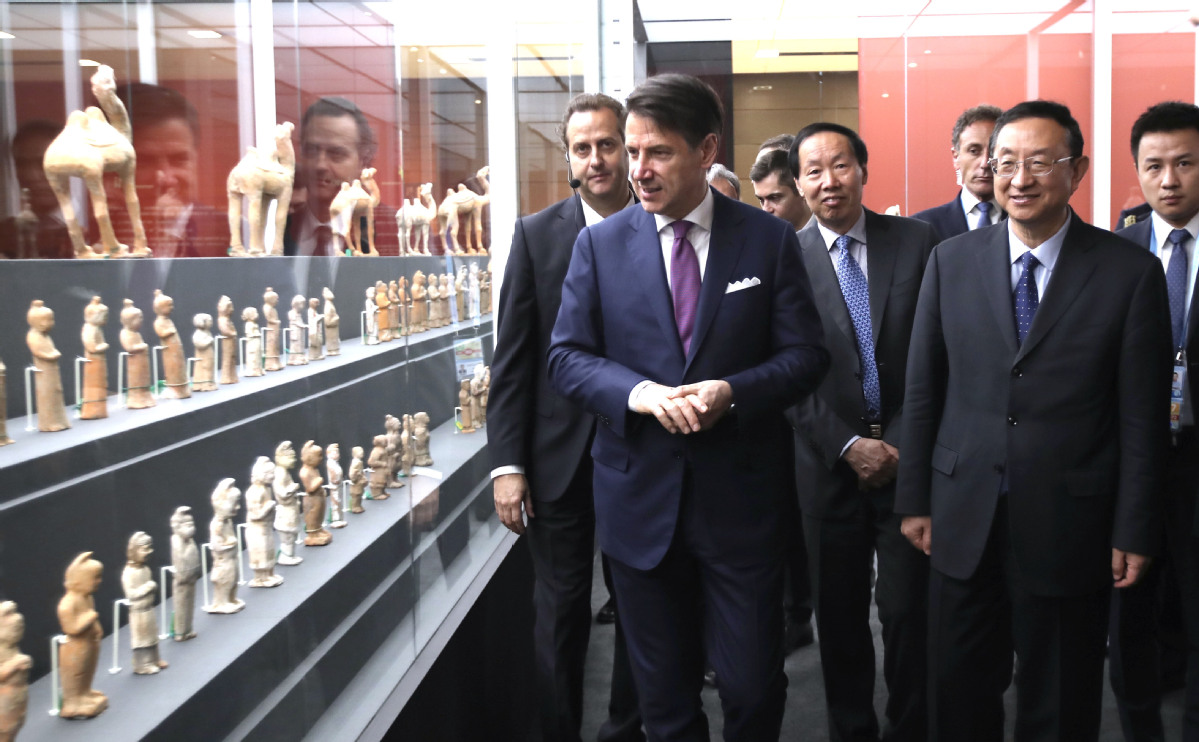'Lost' Chinese artifacts repatriated from Italy
By WANG KAIHAO | China Daily Global | Updated: 2019-04-29 09:31

Hundreds of Chinese cultural relics recently repatriated from Italy are on display at the National Museum of China in Beijing in an exhibition that will run through June.
The 796 artifacts, believed to have been lost, were illegally taken out of the country.
"By flight, it takes only 10 hours to travel from Milan to Beijing," Luo Shugang, Minister of Culture and Tourism, said at the opening of the exhibition on Wednesday. "However, this journey took 12 years."
According to Luo, the artifacts were found in 2007 by the Carabinieri-an Italian law enforcement squad whose duties include fighting cultural heritage-related crimes-in an antiques market in Monza, near Milan.
Suspecting that the relics had been smuggled, the officers confiscated them. After the Chinese embassy in Italy was informed about the seizure in 2008, China's National Cultural Heritage Administration began the process of identifying the artifacts.
It found that no legal permission had been obtained to take the relics abroad.
The Chinese administration then filed to seek repatriation of the relics. After a decadelong judicial process, a court in Milan ruled in November that the artifacts must be returned.
On March 23, an intergovernmental agreement signed in Rome in the presence of President Xi Jinping and Italian Prime Minister Giuseppe Conte gave the green light for bringing the artifacts home.
The 796 relics arrived in Beijing on April 10. "I'm glad to see this exhibition just before the Belt and Road Forum in Beijing," said Ettore Sequi, Italian ambassador to China, at the exhibition's launch on Wednesday. "Italy and China have the largest numbers of UNESCO World Heritage sites," he said, adding that the repatriation will set an example for the rest of the world.
According to Xin Lixiang, a veteran archaeologist with the National Museum of China, some of the artifacts date back to Majiayao, a Neolithic culture from the third millennium BC in today's Gansu province.
Other relics originated in such provinces as Shaanxi, Sichuan, Shanxi, Henan and Jiangsu.
"We can see many pottery figurines of camel caravans from the Han (206 BC to AD 220) and Tang (618-907) dynasties," said Xin. "They provide abundant information on cultural communication and trade between the East and the West."
Porcelain items from the Song (960-1279) and Ming (1368-1644) dynasties are part of the exhibit.
More than 5,000 relics have been brought back to China since the 1980s. In February, China and the United States signed an agreement to secure the return of 361 artifacts.
Guan Qiang, deputy director of the National Cultural Heritage Administration, said the process of repatriation is quite tedious. "The number of relics in this case was big. Obtaining evidence for each item was a difficult task," he said.
Fortunately, Italy has abundant experience in dealing with such cases. The country has gotten back its own lost artifacts from Germany, the US and the Netherlands in recent years.
According to Guan, two international conventions-the UNESCO 1970 Convention on the Means of Prohibiting and Preventing the Illicit Import, Export and Transfer of Ownership of Cultural Property, and the UNIDROIT 1995 Convention on Stolen or Illegally Exported Cultural Objects-prohibit the illegal import and export of cultural items. The UNIDROIT convention obliges buyers to check the legitimacy of their purchase.
But Guan conceded that it is difficult to deal with artifacts lost before 1970.
Sometimes individual Chinese buyers spend a huge amount of money on lost artifacts on the international market and bring them home.
"It's shocking that so many lost Chinese relics were found in one place," said Xin, the National Museum of China archaeologist. "But they are just a drop in the ocean, considering the number of relics stolen or lost, or housed in museums around the world."
Guan said China also prohibits smuggling of overseas relics into the country. In 2018, the heritage administration established an online database of stolen foreign cultural objects, including 6,900 artifacts from Iraq, Peru and other countries.
China and Italy also cooperate in the field of cultural heritage, including training in restoration of cultural relics, exchange exhibitions and joint archaeological surveys.
The Cultural Landscape of Honghe Hani Rice Terraces in Yunnan province and the Vineyard Landscape of Piedmont: Langhe-Roero and Monferrato in northwest Italy have become UNESCO World Heritage sites for exchanging expertise in management and preservation of heritage.
"These achievements are rooted in the two peoples' deep love for history," said Luo, the minister of culture and tourism. "Cooperation in more dimensions will come under the umbrella of the Belt and Road Initiative."
























